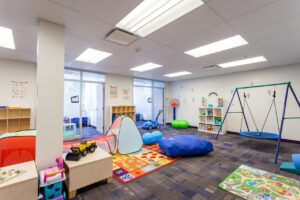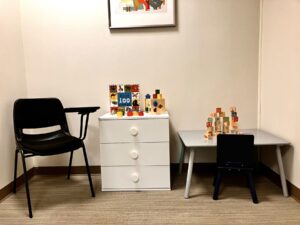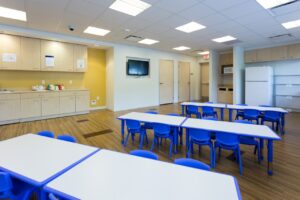Center-Based ABA Benefits

When looking for an ABA provider, families have a lot of factors to consider, such as scheduling, where services are being held, choosing who is offering services, etc. However, personal preference, age, location, and your child’s needs are ultimately what the decision comes down to. ABA is versatile and can take place in a variety of settings. Still, there are significant benefits to a child receiving therapy in a center (Center-based ABA).
ABA therapy centers are:
- Full of fun ways to work on skill-building and behavior
- Interactive with peers and therapists
- Great training ground for preparing young children for academic environments, social opportunities and always buzzing with chances to work on communication
ABA therapy is the scientific approach to understanding human behavior. It puts emphasis on how learning takes place based on how behavior change is affected by the environment. The principles and methods are scientifically proven to be an evidence-based practice by the U.S. Surgeon General and the American Psychological Association.
Components of an Early Intervention ABA Center
Early intervention ABA therapy has become increasingly sought after over the last decade as the world continues to see a rise in the prevalence of ASD. In early intervention, the focus is on the “early years” of life, from 18 months (when a child can be diagnosed) up to around 5 or 6 years old; which are some of the most crucial years for the development of a child.
Therapy Rooms

The therapy rooms in an ABA therapy center serve many purposes and are set up to mimic a school-like environment. Here, therapists can work 1:1 with children for discrete trial training, speech, occupational therapy, or any other more-focused work free from distractions. Working in a space like this allows therapists to control certain variables that might affect learning; and provides children with structure and routine. When ready, therapy moves into busier environments where children must apply what they’ve learned in order to function in school-like settings.
NET Spaces
Net spaces are most likely the preferred place for many children, it serves as an open play area, which no longer feels like therapy. NET stands for Natural Environment Training, it is a place where clients are able to choose activities they like and therapists use these interactions to work on known goals. Some examples of skills worked on in NET spaces include verbal language, listening, and following directions.
Lunch Room

Lunch is a particularly social and interactive opportunity for children at the centers each day. Not only are children with their peers, they are also working on manners, staying in their seats, feeding, and cleaning up amongst other things. If the ABA center offers occupational therapy and children are working on feeding therapy, engaging in this work within a familiar area can build healthy associations.
There are also opportunities to build tolerance for new food smells, as well as chances to work on eating a full meal with distractions in the room. For anyone who’s experienced a school lunchroom, these are good environments to get accustomed to for school.
Bathrooms
Bathrooms are not the most fun thing or place to talk about, but once you become a parent, it becomes an essential topic of discussion during the earlier years. How beneficial is a therapy center with dedicated staff who know your child and consistently work on potty training when they are ready? This is another area where following a consistent schedule and routine proves beneficial to any child. Therapists are also able to work with the children every day on self-care developmental skills that we aim to have transferable to other settings beyond the center.
What Are the Center-Based Benefits?
- Full-time Hours
A full-time center can allow children to have the maximum amount of time working on skills with support and reinforcement from their therapist. Intensive therapy for children with autism is exactly what’s needed at this age to make progress that lasts for the rest of their lives.
- Staff Supervision
Another benefit would be the supervision hierarchy at ABA centers. Children work with RBTs (Registered Behavior Technicians) who are trained and certified to work with the population. At the centers, RBTs are supervised by BCBAs (Board Certified Behavior Analysts) who are master’s and doctorate-level professionals. ABA therapy centers have an entire team of professionals and clinicians working with children each day.
- Parent Training
Research shows that center-based programs tend to have a more robust parent training program compared to home-based programs. Parents are able to interact, ask questions, and learn from a dedicated team of professionals ready to support them and their child; it’s a collaborative approach.
- Speech & Occupational Therapy
Many ABA therapy centers will offer either speech therapy, occupational therapy, or a combination of both. Children diagnosed with ASD often have deficits in speech or fine motor skills, which are worked on with an occupational therapist. Rather than having to drive from therapist to therapist or manage a complex schedule, wouldn’t it be extremely beneficial if your child could receive all of those services under one roof? ABA therapy centers not only provide multiple services, but convenience for many families as well.
Summary
Parents have an increasing number of options these days when it comes to finding adequate ABA therapy for their children. When looking for a provider, make sure to ask the right questions and consider what will be most beneficial for your family. ABA therapy centers best prepare children for real-world experiences with an emphasis on communicating, social skills, transitioning to academic environments and beyond.
For more information about center-based ABA benefits and scientific research backing the claim, check out this page on our website https://allybehavior.com/resources-research/center-based-benefits/
Do you have a young child who is not yet enrolled in school? Wondering if Ally Behavior Centers is the right place for your child to begin their ABA therapy journey?
Give us a call at (240) 342-2666 to find out more information, and we’ll be more than happy to answer any questions you may have.
[References]
https://leafwingcenter.org/who-can-benefit-from-aba-therapy/
Stokes and Baer 1977, “Train and Hope” https://www.ncbi.nlm.nih.gov/pmc/articles/PMC1311194/
David Satcher, MD, Ph.D. United States Surgeon General